Laptop Mag Verdict
Thanks to some subtle design changes, the Razer Core V2 can transform compatible ultraportables into workstations or gaming rigs.
Pros
- +
Slim, attractive design
- +
Easy plug-and-play setup
- +
Customizable lighting
- +
Supports gaming and workstation GPUs
Cons
- -
Expensive
- -
Fans get noticeably loud
Why you can trust Laptop Mag
Razer's doubling down on the external GPU market. The company's second generation of the Core, the Core V2, retains the beautiful lighting and handsome chassis that we've come to expect from Razer, with a few key refinements. The chassis has gotten a little bigger to support more powerful GPUs, including workstation-grade components. The eGPU can send data and charge compatible laptops simultaneously. And thanks to the prevalence of Thunderbolt 3 on newer laptops, the Core V2 can turn more systems into gaming powerhouses. That is, if you can stomach the peripheral's steep $499.99 price.
Design
If you know anything about Razer, you know the company has a signature look. And so it goes with the Core V2, clad in the same lovely black anodized aluminum that you'll find on all the Blade laptops and the previous Core. Speaking of the original Core, the new iteration is virtually identical in looks, which isn't necessarily a bad thing.
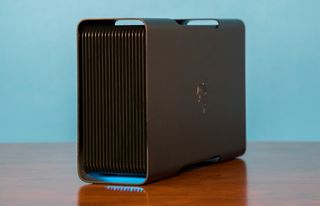
You'll still find the three-headed serpent stamped onto the right side of the device, whereas the left side has a large metallic grille so you can peek at your graphics card awash in one of the 16.8 million colors available with the Chroma lighting. The metallic venting along the front, top and bottom of the eGPU make sure that your graphics card stays nice and cool.
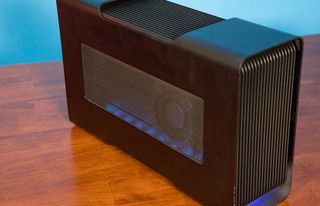
At 10.1 pounds, 11.8 x 5.7 x 1.7 inches, the Core V2 is a bit taller than its predecessor (10.8 pounds, 11.8 x 5.1 x 1.7 inches). That means it can better accommodate larger GPUs, though you can still slide it into a slim space if you don't mind missing out on that lovely lighting. The 12-pound HP Omen Accelerator demands considerably more real estate, measuring 15.8 x 7.9 x 7.9 inches.
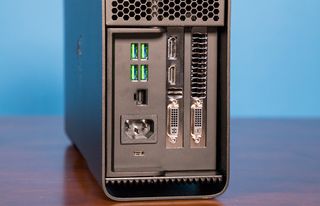
All of your ports, including a quad of USB 3.0 ports, Thunderbolt 3, a gigabit Ethernet port and power port can be found in the back of the device. The Core V2 also has a Quick Release handle, which allows fast and easy access to the interior. The interior of the Core V2 holds the fan and the 500-watt power supply along with the cables needed to connect the system and several bottom-mounted fans.
Compatibility
Since the Core V2 has a Thunderbolt 3 port, it can, theoretically, play nice with a number of laptops, including non-gaming laptops such as the Dell XPS 13 or the HP Spectre 13. However, in order to turn your buttoned-up business laptop or that sleek ultraportable into a gaming force, the notebook in question will require a Thunderbolt 3 port. Unlike the previous model, which required a four-lane port, the Core now works with laptops with dual-lane Thunderbolt 3 port. Since most manufacturers don't provide this nugget of info outright, you'll have to do a bit of digging.
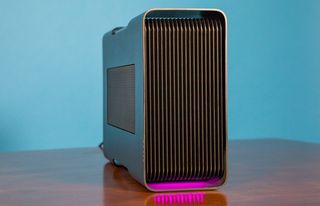
Thanks to the taller case, the Core can support an even wider variety of graphics cards, including Nvidia's 10-series GPUs and AMD's Radeon 500 Series cards. The new eGPU can also supports Nvidia's Quadro GPUs, which are typically used for running double precision computations or CAD (computer-aided design) software.
Setup
Just like with its predecessor, installing your GPU into the Core V2 is a breeze. The process starts by grabbing the Quick Release handle and pulling out the exterior housing. Remove the lone holding screw on the top right and place the graphics card in the enclosure. Once the card is positioned correctly, you replace the holding screw to secure the GPU and connect the plugs. Unlike the previous model, you don't have to restart the laptop for it to register that the Core V2 is attached.
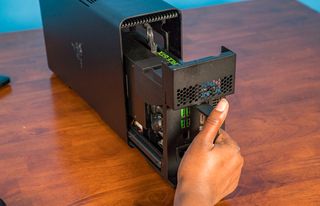
As with everything else in Razer's stable, the Core features the company's hypnotically beautiful Chroma backlighting, which is positioned along the amp's interior and undercarriage. I used Razer's cloud-based Synapse to transform the Core from a handsome metal brick into a show-stealing conversation starter, choosing lighting effects and some of the 16.7 million color at my purview.
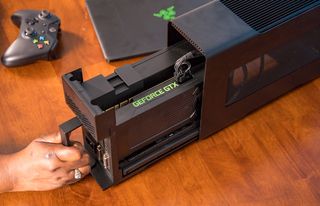
Once I got the Core V2 up and running, I quickly noticed that it's loud, like, distractingly loud -- like, "put on a gaming headset or crank up the computer's volume to max" loud. On one hand, I appreciate how hard those three fans are working. However, compared to the whisper-quiet Omen Accelerator, the Core V2 sounds like a mini jet turbine.
Gaming Performance
Using the Core V2, I transformed the 13-inch Blade Stealth into a gaming system on a par with its bigger, more powerful brethren. I also attached the eGPU to the XPS 13 and the Spectre, bypassing the laptops' integrated Intel UHD 630 GPUs in favor of the desktop Nvidia GeForce GTX 1070 GPU we installed into the Core V2.
MORE: Which GPU is Right For You?
Once everything was up and running, we ran our usual gamut of gaming tests on the Stealth. On the Rise of the Tomb Raider benchmark, where we run the test at 1920 x 1080 on very high, the Core V2 scored 44 frames per second (fps) on the Stealth. The XPS 13 was a frame short at 43 fps, while the Spectre 13 produced 42 fps. We ran the same benchmark with the Omen Accelerator using the same laptops and 1070 GPU and saw each system notch 45 fps.
When we ran the Hitman test with the Core V2, the Stealth hit 65 fps, while the XPS 13 and Spectre obtained 67 and 53 fps, respectively. Switching over to the Omen Accelerator, the Stealth, Spectre 13 and XPS 13 reached 66, 56 and 55 fps.
And feel free to attach an Oculus Rift, HTC Vive or Vive Pro to the setup for some virtual-reality action. The Stealth, Spectre 13 and XPS got scores of 9.6, 9.4 and 9.3 on the SteamVR Performance test, placing each system in the high range of the test. The Omen Accelerator had equally promising scores with the Stealth, Spectre 13 and XPS delivering marks of 9.5, 9.4 and 9.3, respectively.
Bottom Line
Sometimes, it's the small things that matter. For the second generation of the Core, Razer managed to make the eGPU taller to accommodate bigger cards, including workstation-grade GPUs. However, it didn't make it so tall that you couldn't slide it into a medium-size cubby hole for space conservation. And thanks to dedicated lanes in the Thunderbolt 3 design, the Core V2 can simultaneously charge whatever laptop it's connected to while transferring data at blistering speeds. And it's still pretty sexy to boot.
Still, the trio of thunderous fans and exorbitant price are definite road bumps in what should have been a relatively easy recommendation. For $299.99, you can get the Omen Accelerator, which takes up a lot more space but is near silent when in use and can support either a hard drive or an SSD, so you can store your games there instead of on your ultraportable. Still, the Razer Core V2 is a slick way to transform your svelte ultraportable into a viable workstation or gaming laptop.
Credit: Shaun Lucas/Laptop Mag
Razer Core V2 Specs

Sherri L. Smith has been cranking out product reviews for Laptopmag.com since 2011. In that time, she's reviewed more than her share of laptops, tablets, smartphones and everything in between. The resident gamer and audio junkie, Sherri was previously a managing editor for Black Web 2.0 and contributed to BET.Com and Popgadget.